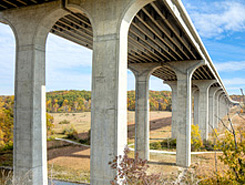Clean Fuels Ohio
The Clean Fuels Ohio works with vehicle fleets, fuel providers, community leaders, and other stakeholders to identify community-driven choices that save energy and promote the use of alternative fuels and advanced vehicle technologies in transportation.
General Stats
- Designated: April 12, 2002
- Population: 11,780,046 (based on 2022 Census estimate)
- Area: 41,260 sq. mi.
- Local/Regional Service Area: Entire state of Ohio
Alternative Fueling Stations
Including public and private stations

- Biodiesel (B20 and above): 4
- Electric (charging outlets): 5,566
- Ethanol (E85): 292
- Hydrogen: 3
- Natural Gas: 47
- Propane: 88
Energy Use Impact*
Annual Energy ImpactEmissions Reduced*
Annual Emissions Reduced.jpg?a03ff447ec)
Cynthia Maves (acting)
Cynthia Maves serves as Vice Chair of the Clean Fuels Ohio Board of Directors. She has 15 years of experience in alternative fuels, fleet electrification, policy advocacy and infrastructure development. She works for HNTB on the energy solutions team. Prior to joining HNTB, Cynthia served as director of fleet and commercial sales at Lordstown Motors and EV business development manager at Nissan North America. She was a staff member of Clean Fuels Ohio from 2010 to 2015. While at Clean Fuels Ohio she served as director of grant administration and staff lawyer, including management of over $30 million in federal and state grants. She also founded and managed Drive Electric Ohio and spearheaded the publication of the DOE-funded EV Readiness Plan for Ohio. She serves on the board of First Federal Savings Bank. Cynthia earned a BA from DePauw University and a JD from Indiana University in Bloomington.
Learn about just some of the projects from Clean Fuels Ohio. Visit the Clean Fuels Ohio website for more projects and information.
Projects and Case Studies- The Ohio Advanced Transportation Partnership
- The Midwest DRIVES Initiative
- Drive Electric Ohio
- Fast Track to Ohio AFV Adoption
- Aggregated Alternative Technology Alliance
- NGV U.P.T.I.M.E. Analysis: Updated Performance Tracking Integrating Maintenance Expenses
- Heavy-Duty Electric Vehicle Demonstrations for Freight and Mobility Solutions
- Decentralized Mobility Ecosystem: Market Solutions for 21st Century Electrified Mobility
- Zero Emission Freight Future
- Midwest EVOLVE (Midwest Electric Vehicle Opportunities: Learning, Events, Experience
- Safety Training and Design, Permitting, and Operational Guidance for Garage Facilities Maintaining and Parking Natural Gas, Propane, and Hydrogen Vehicles
- Clean Cities Coalitions Enlighten Local Fleets on Landfill Gas as Fuel
- City of Cincinnati Turns Efficient Fleet Plan into On-Road Reality
- Smith Dairy Deploys Natural Gas Vehicles and Fueling Infrastructure in the Midwest
 quasar energy group Turns Organic Waste into Renewable Energy in Ohio
quasar energy group Turns Organic Waste into Renewable Energy in Ohio
 Cleveland Car Dealership Working Toward a More Sustainable Future
Cleveland Car Dealership Working Toward a More Sustainable Future
 Frito-Lay Delivers With Electric Truck Fleet
Frito-Lay Delivers With Electric Truck Fleet
 Yellow Cab Converts Taxis to Propane in Columbus, Ohio
Yellow Cab Converts Taxis to Propane in Columbus, Ohio
 Alternative Fuel Vehicles Lower Emissions in Columbus, Ohio
Alternative Fuel Vehicles Lower Emissions in Columbus, Ohio

